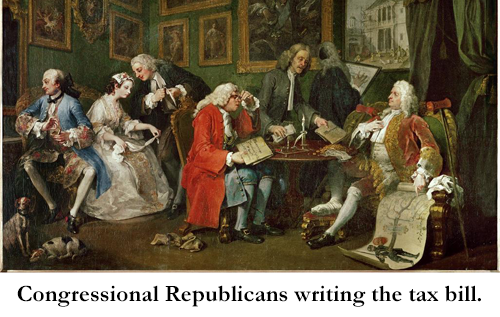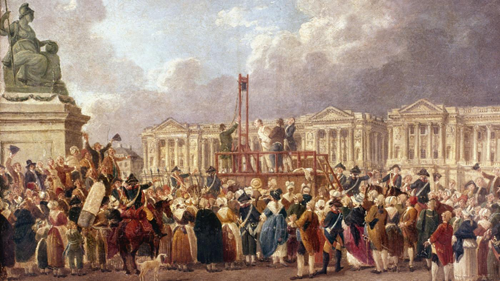Trump is supposed to unveil his infrastructure plan some time this month. Trump has made grandiose noises about investing $1 trillion to fix the nation’s infrastructure. However, so far he has only allocated $200 billion in federal funds for infrastructure repair.
So, as with all things Trump, one must ask — where’s the grift?
Sources told Politico that Trump will split the infrastructure bill into three sections: streamlining bureaucracy, increasing funding and ending the agency review process. He would like to allocate $200 billion for infrastructure projects over the next decade, Politico reported, and expects the rest of the money to come from private-public partnerships and state and local funding.
$200 billion for infrastructure projects over the next decade? For the entire country? Might as well fund it all with Home Depot coupons.
Cohn [Gary Cohn, director of the White House National Economic Council] claimed that states and localities already have the money to complete large-scale infrastructure projects but are hindered by red tape at the federal level. White House officials have said states and municipalities that want such things as new bridges or broadband internet access will be asked to compete for federal assistance by proving they’re willing to put their own money down and raise revenue from taxes, fees and other sources.
States and localities already have the money? On what planet?
Even better, Trump may be getting some of his ideas from Mike Pence. Lydia O’Neal and David Sirota at Newsweek:
President Donald Trump’s $1 trillion plan to rebuild America’s infrastructure may be unprecedented in size and ambition, but it mimics a controversial scheme championed by Vice President Mike Pence when he was the governor of Indiana. That’s why Pence is the public face of the Trump initiative, and executives from financial firms that helped privatize Indiana’s toll road are in the White House, busily sculpting Trump’s national plan.
Pence and his allies like to boast about how Indiana sold control of major roads to private firms, claiming the move prompted corporations to invest money in infrastructure that would otherwise have been funded by taxpayers. But opponents say Indiana made some bad deals that offer a cautionary tale of get-rich-quick scheming, secrecy and cronyism that led the state to sell off valuable assets that were then wildly mismanaged.
A bit more googling led me to a June 2017 news story at the Indianapolis Star about the unmitigated disaster that was Mike Pence’s experiment in infrastructure upgrades.
At first, it sounded like a good idea: Indiana would use a public-private partnership to extend I-69 from Bloomington to Martinsville, relying on private sector ingenuity to bring it in on time and under budget.
But the project is two years behind schedule. The prolonged construction has increased traffic accidents and lengthened commute times. And, now, as the state is dissolving the partnership — which some argue could end up costing Hoosiers millions of dollars — a difficult question needs to be asked:
How did this once-touted project — pitched and promoted by then-Gov. Mike Pence as a model for smart infrastructure planning — become such an embarrassing mess?
It became an embarrassing mess because officials in Pence’s administration inexplicably awarded the contract to a Spanish company that had no clue what it was doing. The project added new meaning to the word “boondoggle.” The Spanish company, Isolux Corsan, gave an absurdly lowball bid that was $22 million less than the state’s own cost estimate. And the Pence Administration seems to have done no vetting of this company at all. However …
A mere three weeks after the contract was finalized, before bonds were floated to finance the work, nine company and public officials in Spain were arrested on embezzlement charges. The allegation? They had profited illegally from a bribery scheme related to a high-speed rail project built by Isolux, a scandal that’s still unfolding in Spain.
State officials did not respond when asked by IndyStar if they were aware of the arrests.
One suspects those Pence Administration officials did quite well. One suspect Trump and his cohorts expect to do quite well also.
However, there also are indications that Trump expects to dump all the responsibilities and burdens for making his plan work on states and cities. Laura Bliss writes for The Atlantic:
Trump began to emphatically state that private investment would not be the focus of his eventual infrastructure plan. In a White House meeting September, The Washington Post reported that the president pointed to well-known examples in Vice President Mike Pence’s home state of Indiana of how private-public partnerships can leave the government saddled with debt if contracts aren’t carefully negotiated at the start. The new funding focus: states and cities.
At an event in early December, DJ Gribbin, an infrastructure-policy adviser to President Trump, described the new plan as an “incentive program.†“Part of what we want to do … is say, ‘Listen, if you as a state or local elected official are willing to create a new revenue stream for infrastructure, we as the federal government want to partner with you in doing that,’†Gribbin said.
‘Listen, if you as a state or local elected official are willing to create a new revenue stream for infrastructure, we as the federal government want to partner with you in doing that’ – What does that even mean? Well, basically, it means that states and localities will be expected to jack up taxes and user fees to pay for whatever they want repaired, and the Trump Administration will dribble out some of its $200 billion budgeted for a whole bleeping decade for the whole bleeping country to sweeten the pot.
On what planet would that even work?
Gribbin has said the White House plan will lay out “clear, measurable, objective criteria†for how localities and states would win money. But Tomer [Adie Tomer, a fellow at the Brookings Institution’s Metropolitan Policy Program] said the details he’s seen place less stress on the nature of the projects it would fund, and more on who would be paying for them. “The more you come up with new revenue, the more likely you are to get help from the feds. This is going to be the key to the details,†he said.
In other words, the poorest parts of the country that need the most help can kiss Trump’s ass. And there’s no prioritizing of any sort.
By effectively dangling infrastructure grants to the highest bidder, the White House’s proposal could pressure those same layers of government to corral what few resources they have into paying their share of an infrastructure plan. Cities that never financially recovered from the recession, like Detroit, Cleveland, Stockton, and Memphis, may feel especially limited in their spending options if federal grants are only available for big spenders.
“It’s an interesting time to be asking this sector to be more creative with revenue sources,†Gordon said. “Trying to get them to share more of the funding burden is probably not going to go over that well.â€
It’s not going to help that this let-the-states-pay-for-it plan is coming on the heels of the Tax Law of Doom.
The new law, signed by President Trump on the Friday before Christmas, will add nearly $1.5 trillion to the federal budget deficit over the next decade, according to the Congressional Budget Office. That in turn is likely to trigger cuts to discretionary programs that help communities build roads, fly planes, drink clean water, and connect to the internet.
And, of course, a whole lot of vital infrastructure is interstate. How’s that going to work out?





